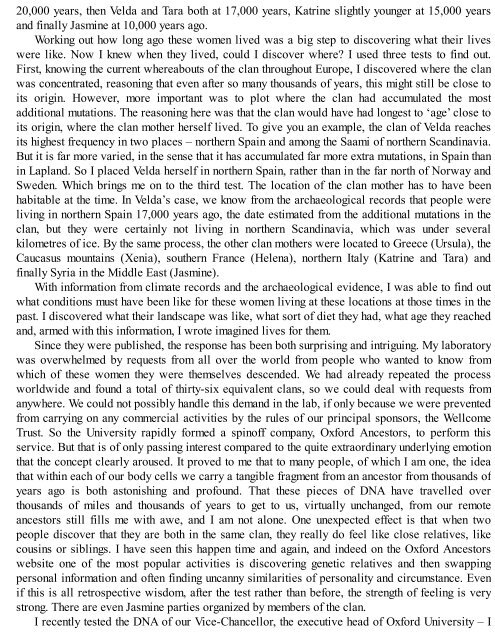Create successful ePaper yourself
Turn your PDF publications into a flip-book with our unique Google optimized e-Paper software.
20,000 years, then Velda and Tara both at 17,000 years, Katrine slightly younger at 15,000 years<br />
and finally Jasmine at 10,000 years ago.<br />
Working out how long ago these women lived was a big step to discovering what their lives<br />
were like. Now I knew when they lived, could I discover where? I used three tests to find out.<br />
First, knowing the current whereabouts of the clan throughout Europe, I discovered where the clan<br />
was concentrated, reasoning that even after so many thousands of years, this might still be close to<br />
its origin. However, more important was to plot where the clan had accumulated the most<br />
additional mutations. The reasoning here was that the clan would have had longest to ‘age’ close to<br />
its origin, where the clan mother herself lived. To give you an example, the clan of Velda reaches<br />
its highest frequency in two places – northern Spain and among the Saami of northern Scandinavia.<br />
But it is far more varied, in the sense that it has accumulated far more extra mutations, in Spain than<br />
in Lapland. So I placed Velda herself in northern Spain, rather than in the far north of Norway and<br />
Sweden. Which brings me on to the third test. The location of the clan mother has to have been<br />
habitable at the time. In Velda’s case, we know from the archaeological records that people were<br />
living in northern Spain 17,000 years ago, the date estimated from the additional mutations in the<br />
clan, but they were certainly not living in northern Scandinavia, which was under several<br />
kilometres of ice. By the same process, the other clan mothers were located to Greece (Ursula), the<br />
Caucasus mountains (Xenia), southern France (Helena), northern Italy (Katrine and Tara) and<br />
finally Syria in the Middle East (Jasmine).<br />
With information from climate records and the archaeological evidence, I was able to find out<br />
what conditions must have been like for these women living at these locations at those times in the<br />
past. I discovered what their landscape was like, what sort of diet they had, what age they reached<br />
and, armed with this information, I wrote imagined lives for them.<br />
Since they were published, the response has been both surprising and intriguing. My laboratory<br />
was overwhelmed by requests from all over the world from people who wanted to know from<br />
which of these women they were themselves descended. We had already repeated the process<br />
worldwide and found a total of thirty-six equivalent clans, so we could deal with requests from<br />
anywhere. We could not possibly handle this demand in the lab, if only because we were prevented<br />
from carrying on any commercial activities by the rules of our principal sponsors, the Wellcome<br />
Trust. So the University rapidly formed a spinoff company, Oxford Ancestors, to perform this<br />
service. But that is of only passing interest compared to the quite extraordinary underlying emotion<br />
that the concept clearly aroused. It proved to me that to many people, of which I am one, the idea<br />
that within each of our body cells we carry a tangible fragment from an ancestor from thousands of<br />
years ago is both astonishing and profound. That these pieces of DNA have travelled over<br />
thousands of miles and thousands of years to get to us, virtually unchanged, from our remote<br />
ancestors still fills me with awe, and I am not alone. One unexpected effect is that when two<br />
people discover that they are both in the same clan, they really do feel like close relatives, like<br />
cousins or siblings. I have seen this happen time and again, and indeed on the Oxford Ancestors<br />
website one of the most popular activities is discovering genetic relatives and then swapping<br />
personal information and often finding uncanny similarities of personality and circumstance. Even<br />
if this is all retrospective wisdom, after the test rather than before, the strength of feeling is very<br />
strong. There are even Jasmine parties organized by members of the clan.<br />
I recently tested the DNA of our Vice-Chancellor, the executive head of Oxford University – I
















